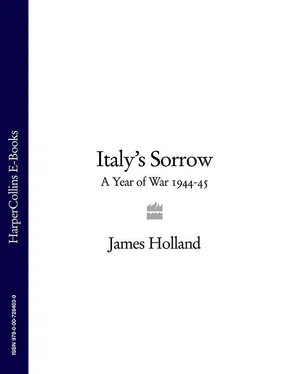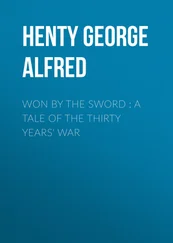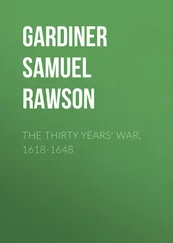Leese was impatient for the battle to begin, and though apprehensive was quietly confident. ‘Ultra’ intercepts of German Enigma codes passed on by the Government Code and Cypher School at Bletchley Park, Buckinghamshire, suggested that the Allies’ elaborate deception plans had worked and that the Germans were not expecting a major attack until the following month. Leese had more than a quarter of a million men under his command – ‘an immense army’ – all of whom were fully trained and briefed. Ammunition and petrol were ready in dumps at the front line. Everyone was agreed on the battle plan, and from his manic tours around the front, Leese believed his troops to be in good heart. ‘It has been a vast endeavour and it will be a huge battle,’ he wrote. ‘All we want is fine weather and a bit of luck.’8
As the evening shadows lengthened, infantrymen along the front furtively began moving up to their start lines and forming-up positions. In the Liri Valley, men uncovered assault boats; bridging parties moved trucks of Bailey bridge sections forward, while other sappers reeled out long lines of white marker tape to later guide the troops in the dark towards specific river crossing points.
Dusk soon gave way to the darkness of night, and the first desultory shelling of Cassino began just as it had every night for weeks since the end of the third battle of Cassino in March. Partly as cover, and partly to give the impression that this was just like any other evening along the front, the shelling gradually died out, so that at ten o’clock, when General Leese sat down to write to his wife, Margie, the front seemed eerily quiet.
‘In sixty minutes,’ he scrawled on the thick blue writing paper Margie Leese had sent out to him, ‘hell will be let loose, the whole way from Monte Cairo to the sea. At 11 p.m. on 11 May, 2,000 guns will burst forth.’ * * Leese was never particularly accurate with his facts and figures when writing to his wife. In fact, there were around 1,660 guns in action: 1,060 along Eighth Army’s front, and 600 along that of Fifth Army.
It had, he added, been a lovely day, and it was now a glorious night.
A huge weight of responsibility rested on Leese’s shoulders and those of his fellow commanders, not only for the men under their command but also because there was so much at stake with this, the biggest battle the Western Allies had yet attempted in the war. A sweeping, crushing victory promised untold riches, yet defeat would not only be a blow to Allied chances of success in launching an invasion of northern France, but it would also wreck the future of the Italian campaign and with it British credibility in particular. No wonder General Leese was counting down the minutes.
*Although they were now operating as infantry, the Polish cavalry and armoured units kept their usual structure and formation.
*Allied Central Mediterranean Forces had become Allied Forces in Italy on 9 March 1944.
*The 85th was given the association ‘Custer’ because the division was activiated in 1917 at Camp Custer in Michigan, so named after the Civil War and Indian Wars general who had led the Michigan Cavalry Brigade at the Battle of Gettysburg.
*There were 158,805 men in AOK 10 and AOK 14, while Alexander could call on 602,618 Allied troops in Italy at this time, of whom 253,859 were British, 231,306 were American, 71,827 were French and 45,626 were Polish. Although nothing like this number would take part in the coming battles, Alexander was still able to have the three to one advantage in manpower along the main battle line that he believed was necessary for victory. Even so, when one considers the air forces and men in reserve, the best part of a million men were to be directly and indirectly involved in the offensive.
*Leese was never particularly accurate with his facts and figures when writing to his wife. In fact, there were around 1,660 guns in action: 1,060 along Eighth Army’s front, and 600 along that of Fifth Army.
TWO
Battle Begins 11–12 May 1944
Manning his machine-gun post amongst the rubble near what had once been the Via Casilina – the main road to Rome – was Hans-Jürgen Kumberg. The 4th Fallschirmjäger Regiment had moved down from the heights of Monte Cassino a month earlier. Although the ruins provided excellent defensive cover, the place was a hell hole, swarming with malaria-infested mosquitoes and reeking of death and sewage. The men were short of just about everything: water, food, cigarettes; reinforcements that had been promised but had not materialised. And they were exhausted: living like sewer rats and being pummelled by relentless Allied harassing fire was not conducive to sleep. Only the Pioneer – engineers – battalion of the 4th Regiment had arrived to help, having joined them alongside the Via Casilina just the day before.
Amongst them was twenty-three-year-old company commander Lieutenant Joseph ‘Jupp’ Klein, a battle-hardened veteran of the Eastern Front, Sicily and the second and third battles of Cassino. His company’s recent leave had been the first since arriving in Italy the previous August following the Sicily campaign and had done much to revive their spirits, but after a day back at the front they still had much to do. There were more machine-gun positions to be built, more tunnels to dig and retreat routes to be prepared.
On the night of 11 May, at eleven o’clock, Jupp Klein was standing on the debris-strewn Via Casilina, talking to one of his corporals, when ‘suddenly from heaven to hell the night became as bright as day’.9 As the shells screamed overhead, Jupp immediately recognised that the sheer scale of the barrage could only mean one thing: the offensive had started – and sooner than any of them had expected.
A few miles north in a concrete bunker along a narrow valley between the mountains above Cassino, Major Georg Zellner, commander of the 3rd Battalion Hoch- und-Deutschmeister Reichs Grenadier Regiment, gathered around him a few of his officers. Throughout the day he had been receiving the best wishes of his men on this his thirty-ninth birthday. Some of his staff had even brought him some flowers picked from the mountain. The major, however, was not in good spirits. Desperately homesick, he hoped for a letter or card from his wife and two young daughters back home in Passau in south-east Germany, but nothing had yet arrived. All day, he’d waited, praying there would be some word from them on the evening’s ration cart but nothing came.
Two bottles of sekt – sparkling wine – had arrived for him and he and a few of his officers were about to share them. Having eased the cork from the first of the bottles, Georg was about to take a birthday gulp when the world seemed to be ripped apart as the massed Allied guns roared the opening salvo of the battle. ‘We drink the sekt anyway,’ he noted drily.10
Watching the barrage from the safety of Monte Trocchio, behind the Allied lines, was twenty-eight-year-old Lieutenant Ted Wyke-Smith, a former steel engineer from Sheffield now serving with 78th Division Royal Engineers. As commander of a bridging unit, his job was to be amongst the division’s spearhead as it advanced, once the 4th and 8th Indian Divisions had made the initial breakthrough, and build Bailey bridges over the numerous rivers and anti-tank ditches that barred the Allied progress. Ted had been sitting in his tented dugout listening to nightingales in the trees nearby when the guns opened fire. ‘It was terrific,’ he remembers. ‘The noise was incredible and even where we were, several miles behind the lines, the ground trembled.’ Curiously, however, the nightingales began singing again shortly after. ‘It was most extraordinary,’ says Ted, ‘a concerto of nightingales and cannons.’
Читать дальше











